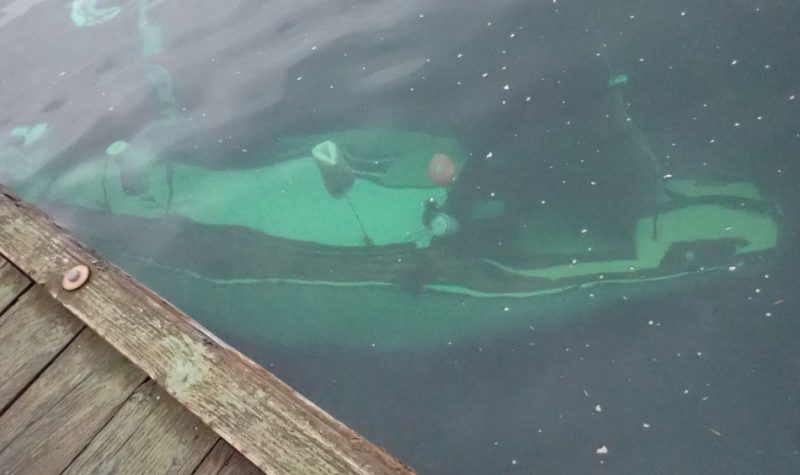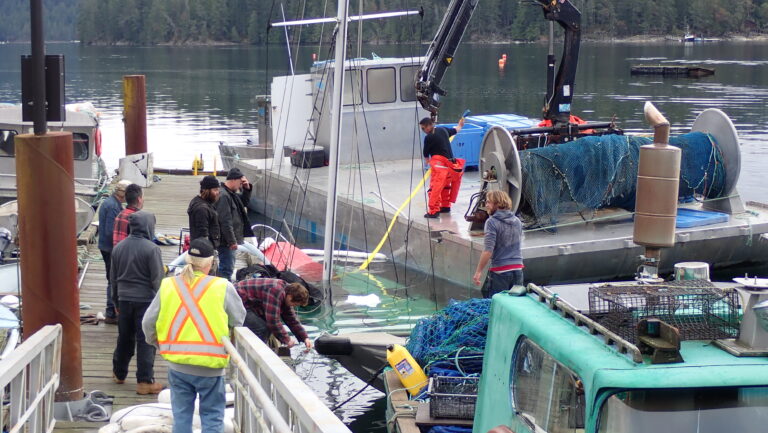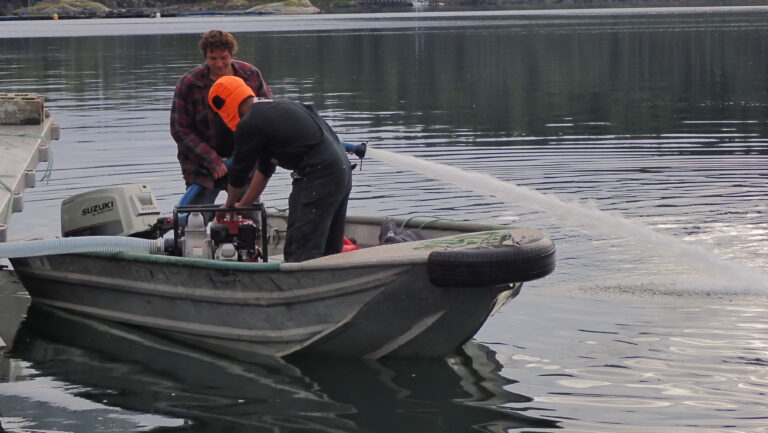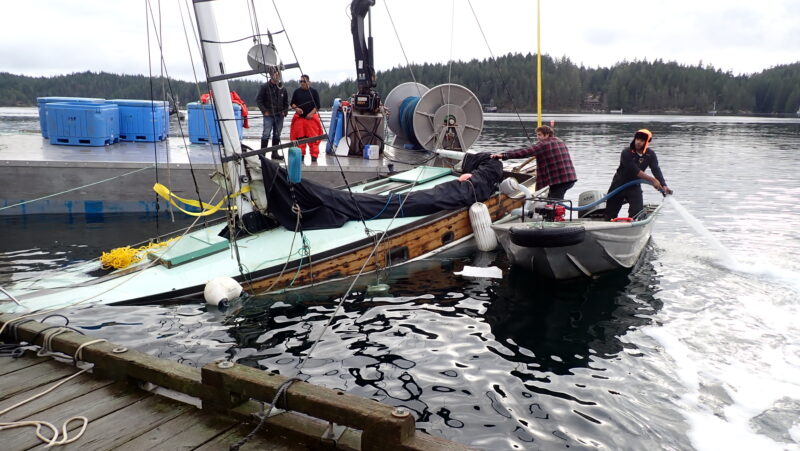By De Clarke
On or around November 22nd, the 30-ish foot wooden sloop Hoy Hoy sank while tied to the Gorge Harbour Public Dock.
Hoy Hoy‘s Story
Hoy Hoy has made more than one ocean crossing, but most recently belonged to an American who seems to be known locally only as “Earle.” He visited Cortes in 2019 for an extended period, living aboard with his young son on the Gorge Harbour Marina dock. He left the country in the Fall, prepaying four months’ moorage and intending to return in February or March of 2020.
Over the winter of 2019/20, Hoy Hoy took on water slowly but steadily and had to be pumped out regularly by neighbour Rodney Pohl. Then along came a pandemic, and Earle was unable to travel to Canada. Unfortunately, he also didn’t pay any more moorage (after February).
Each year when tourist season begins, Bill Dougan (manager of GHM) asks liveaboards and locals to remove their boats from his docks, to make room for summer visitors who pay higher seasonal rates for shorter stays. “In May,” Bill recalls, “some strangers came and took Hoy Hoy away.”
A Homeless Boat
The boat apparently went as far as Owen Bay, on Sonora Island, where it stayed for some time on the public dock. Friends or local contacts of the owner pumped it out regularly, but there came a point when they could no longer be responsible for it. “So one day, ” Bill recalls, “I saw a boat being towed into Gorge and I said Oh no, it’s back. And it was heading for our dock, so I went down there.”
The people bringing the boat in said that they had been assured the moorage issue was settled and the boat could come back to GHM. Bill told them otherwise: “If that boat’s on my dock when I get back, it belongs to me. The guy owes me a grand.”
The boat was not there when Bill got back. It had been moved to the Whaletown public dock. To oblige Earle, Bill visited the boat to check on it: “I had actually been pumping the boat out every five days.”
“I had a few conversations with him about the boat,” says Bill, “but whenever the question of paying for the moorage came up, I wouldn’t hear back from him.”
And Then It Sank
“The day before it sank,” Bill recalls, “another sailboat tied up to it. He checked the boat out for seaworthiness and felt confident rafting up to it. He left for a few hours, and when he returned saw Hoy Hoy‘s mast sticking up out of the water. He told me he was shocked — because there was nothing wrong with the boat several hours earlier.”
The sunken boat was blocking access to a section of the public dock, and was very slowly leaking oil/diesel. There was only a “drip” (upward to the surface) every 30 seconds or longer, but over time it would accumulate. The question now was what to do about it.
Island Sea Farms helps out
Jenny Hartwick is the harbourmaster for HACI (Harbour Association of Cortes Island). A sunken boat at one of their docks can be very bad news; but Jenny says, “Bill was a real community hero here, he took responsibility for a vessel that wasn’t even his, and made arrangements [with ISF] to have it moved the day after it sank. The weather delayed that a day or so.”
Island Sea Farms has a very capable aluminium barge with a Hiab hydraulic crane. They also make regular use of the public dock and ramp facilities. Before long, ISF was contacting DFO to get their blessing on lifting Hoy Hoy. (This phone call was somewhat important; without DFO’s blessing, anyone trying to lift a sunken vessel is personally responsible for any oil spills or other environmental contamination that may ensue.)
On a gray but dry late morning on November 25th, the salvage operation began. To “rescue” a sunken boat, you lift it until the deck and hatches are just clear of the water, then use a gasoline-powered pump to suck the water out until the boat floats on its own. This is what ISF did over the course of several hours. Despite one exciting moment when a lifting line snapped, patience was rewarded and the boat floated again.
Possible Cause?
In talking with the ISF crew who raised the boat, Bill learned some new information which he found troubling. “When the boat was retrieved, it was discovered once it was pumped out that the head valve was open and water was rushing in. It is believed at this point that the valve was opened deliberately — since it was not faulty or damaged, but simply open.” Most mariners are careful to close the head valves when a boat is left unattended for any appreciable time, so it’s unusual to find it open on a stored boat.
Bill says, “My best guess is someone opened the valve — the boat had no holding tank so the waste would have gone straight into the ocean. Either someone opened it up on purpose to scuttle it, or they used the head and — not knowing any better — left the valve open which sunk it .”
Plans to demolish the vessel
Though it’s possible to repair and reclaim a sunken boat, the cleanup effort is enormous and the engine and electronics can be a write-off. The plan (as explained to me at the time by people on the dock) was to tow Hoy Hoy over to the log dump, haul her up on shore, and demolish the vessel. This apparently encouraged some Gorge Harbour locals to start stripping the boat for salvageable fittings and gear.
Not all agree that a write-off was inevitable, though. The boat has intrinsic value and pedigree.
Hoy Hoy was built by the Woodnutt Co. of St Helen’s, Isle of Wight in the UK. The designer was Frederick R Parker, a successful marine architect whose best-known design was the famous Maybird. Given the build quality and materials used, it’s most likely she was built after WWII but before the era of fibreglass, and was a “gold plater” in her day.
“It’s a real shame,” says retired wooden shipwright and Cortes Island resident Jon Knowles. “That boat was a superb build. I had a peek inside after she was refloated and the planking looks like Honduras mahogany, copper-riveted throughout. It was built by a professional, high-quality builder, maybe as long ago as the 40’s or 50’s. There are custom bronze castings, the standing rigging is beautifully parcelled and served. I mean, that was a gorgeous, yacht-quality boat, real craftsmanship. And it had a new mast, a new sail, and a Yanmar engine younger than the one in my boat. Someone put quite a bit of money into a refit of that hull because it’s a really high-class build and worth preserving… and now it’s been wrecked.”
The new mainsail, bagged headsails, the bronze portlights, primary self-tailing winches and anything else of value aboard were stripped by locals as soon as the boat was raised. When I visited her late in the evening the following day (still at the HACI dock) even the fenders had been taken.
Some waterfront denizens say this is simply “right of salvage” when a vessel is sunk; others say it was not appropriate because the boat still belongs to its legal owner and — at most — ISF and Bill Dougan can and should have a lien on it for the unpaid moorage bill and the costs of salvage. HACI has been unsuccessful so far in contacting Earle in the US.
Local boat owners say that theft and vandalism have been on the increase at the Gorge Harbour public dock in recent years.
Check Your Bilge Pump!
ISF kindly undertook this operation gratis, paying a crew of half a dozen or so (including two commercial divers) for several hours’ work. These images of a salvage operation may help non-maritime readers to understand exactly how costly it is to deal with a derelict or abandoned vessel that has sunk in a working harbour or navigable channel.
These kinds of emergencies are likely to become more common as an ageing fleet of pleasure and work boats “goes down the food chain” to owners less and less able or willing to maintain and attend them. If you own a boat kept in the water on Cortes Island, please make sure your bilge pump works! And if your boat does sink and needs rescue, you should probably be present to protect it from enthusiastic “salvagers.”












